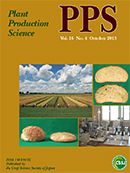Volume 16, Issue 4
Displaying 1-12 of 12 articles from this issue
- |<
- <
- 1
- >
- >|
Crop Physiology
-
2013Volume 16Issue 4 Pages 287-294
Published: 2013
Released on J-STAGE: September 27, 2013
Download PDF (702K)
Genetic Resources Evaluation
-
2013Volume 16Issue 4 Pages 295-304
Published: 2013
Released on J-STAGE: September 27, 2013
Download PDF (710K)
(Short Report)
-
2013Volume 16Issue 4 Pages 305-308
Published: 2013
Released on J-STAGE: September 27, 2013
Download PDF (628K)
Agronomy & Crop Ecology
-
2013Volume 16Issue 4 Pages 309-316
Published: 2013
Released on J-STAGE: September 27, 2013
Download PDF (658K) -
2013Volume 16Issue 4 Pages 317-324
Published: 2013
Released on J-STAGE: September 27, 2013
Download PDF (760K) -
2013Volume 16Issue 4 Pages 325-334
Published: 2013
Released on J-STAGE: September 27, 2013
Download PDF (656K) -
2013Volume 16Issue 4 Pages 335-341
Published: 2013
Released on J-STAGE: September 27, 2013
Download PDF (759K) -
2013Volume 16Issue 4 Pages 342-351
Published: 2013
Released on J-STAGE: September 27, 2013
Download PDF (933K) -
2013Volume 16Issue 4 Pages 352-364
Published: 2013
Released on J-STAGE: September 27, 2013
Download PDF (1846K) -
2013Volume 16Issue 4 Pages 365-373
Published: 2013
Released on J-STAGE: September 27, 2013
Download PDF (777K) -
2013Volume 16Issue 4 Pages 374-382
Published: 2013
Released on J-STAGE: September 27, 2013
Download PDF (580K) -
2013Volume 16Issue 4 Pages 383-392
Published: 2013
Released on J-STAGE: September 27, 2013
Download PDF (3017K)
- |<
- <
- 1
- >
- >|
